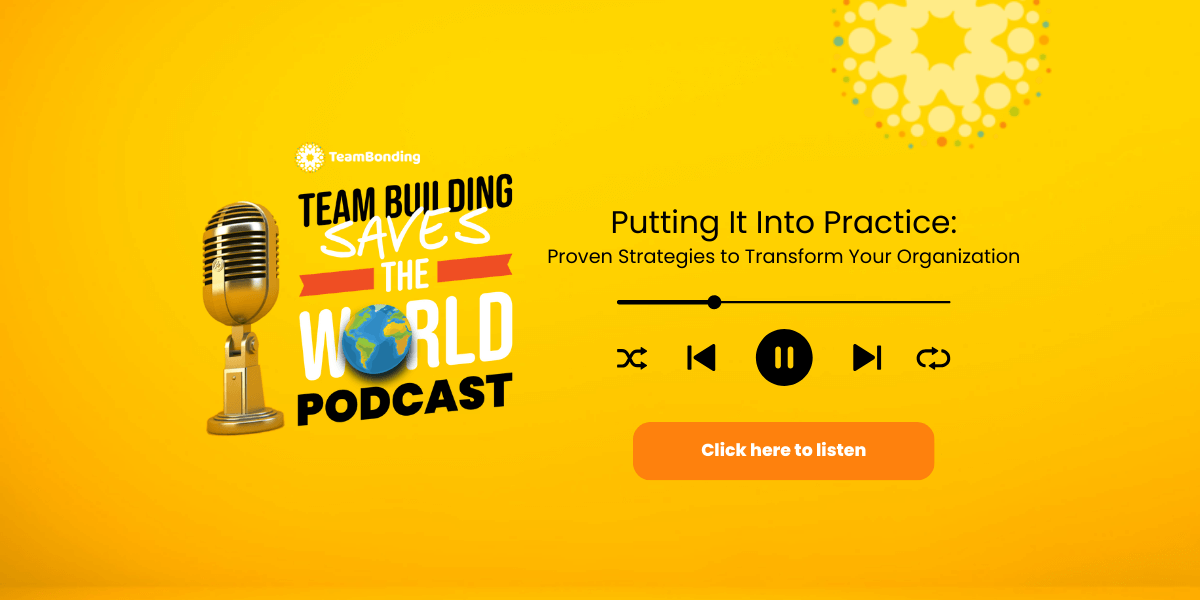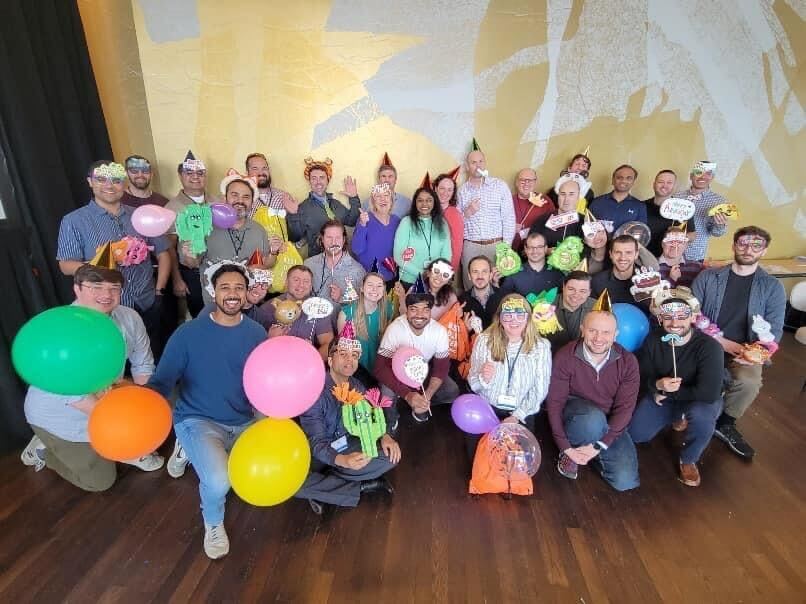Organizational transformation is key if you want your business to be successful. In simple terms, organizational transformation is the process of making changes to your business, its culture, and its processes. Markets are always changing, and so is technology. To weather those changes, you have to be able to adapt and make changes.
On our most recent episode of the Team Building Saves the World podcast, we talked to Lisa Nordquist—Certified Mayo Clinic Health and Wellness Coach and founder and CEO of Gray Monkey Group. A key highlight was her focus on the continued effort organizational transformation takes, saying:
“It’s limbic learning. That means there has to be other elements in play for people to really get it and keep doing it… They say it’s easy to drop 20 pounds, but what’s hard is keeping the 20 pounds off. It’s the same thing with this.
In today’s blog, we’re going to take a closer look at organizational transformation. We’ll cover the basics of what is organizational transformation, why it’s important, tips and strategies, common challenges, and more.
Understanding the Need for Organizational Transformation
First, let’s start off by looking at why organizational transformation is important. If you don’t understand why it’s a necessity, it will be much harder to actually make a lasting and impactful change.
As mentioned in the introduction, the world is forever changing. Markets trend up and down, new technologies emerge, and new generations enter the workplace. All of these things create a need for change.
For example, Gen Z’s wants in the workplace are different from Gen X. And Gen X’s wants in the workplace are different from the Baby Boomers. Every generation has its own needs and wants, and employers risk losing highly qualified and capable employees if they don’t adapt. Because of that, an organizational culture transformation is often a necessity.
Technology is another easy example. There are new technologies every year, and they can disrupt entire industries. There are countless examples of companies that failed to accommodate new technology, and they ended up faltering as a result. You have to be ready to accept new tech, make changes, and adapt to the future.
There can also be internal catalysts. Workplace culture can shift over time. Many workplaces get complacent and stuck in their ways, and eventually they are forced to change. Maybe new management comes in and wants to make the culture more positive.
Either way, there are numerous factors that can make an organizational transformation a necessity. At the end of the day, the world is always changing and businesses will always need to make changes to adapt.
Key Components of Successful Organizational Transformation
Now, let’s look at a few key components of any organizational transformation model. There are many more factors that contribute, but these are the key things to focus on.
One of the main components is embracing change. Whether it be new technology, new ideas, or innovations from within, companies need to embrace whatever comes next. That doesn’t mean mindlessly jumping into every new trend, but you need to be ready to try something new and see how it turns out.
Another big component is having a clear vision and strategy. Employees need to know why the change is happening and what exactly that looks like. Having everyone on the same page goes a long way in making an organizational transformation easier. It’s also necessary in general to have an actionable plan to follow.
That also helps empower employees and boost engagement, which is another big component. Employees need to feel like they are taking an active role in things, and communicating your vision and plan can help with that.
Last but not least, leadership needs to be aligned and committed. People follow their leaders, so your leaders need to be in agreement and ready to go. Having a strong team of leaders united in their goal can have a huge impact.

Strategies for Implementing Organizational Change
So, how do you actually implement an organizational change? Don’t worry—we’re going to look at some organizational transformation strategies that can help you get started.
Changing management models is often one of the most effective strategies. Again, employees follow their leaders. How you manage your business and employees impacts everyone at the company. Changing your management models to support the change is essential for organizational change.
Tying into that, you need to be agile and adaptive. Things are always changing, and what you try may not work. You have to be ready to make changes as necessary where they are needed. If you get stuck and can’t adapt, you’ll have a hard time making a change.
Another good strategy is team building. It has numerous benefits, such as improving leadership skills, increasing team connection, and more. All of those can directly translate into making your organizational change more effective.
On top of that, you’ll get to have fun. Though it may seem unnecessary, having fun is arguably the best way to bring your team together. Nordquist even noted the importance of fun in the workplace, saying, “People need to have fun. This is a great place to do it. And you can really capitalize on that with training.”
Overcoming Common Challenges
Though that last section may make it seem like organizational transformation is easy, that is not always the case. Big change often comes with a slew of challenges and hurdles, so let’s take a moment to address them.
The biggest challenge many face when implementing an organizational transformation is communication. Communication breakdowns can easily arise, and they can derail your transformation.
Thankfully, this one is pretty easy to address. Put a focus on effective communication, and make sure your goals, changes, plans, etc, are communicated fully to everyone. That alone can have a big impact.
Also, make sure everyone gets heard. Taking the time to make sure everyone can voice their concerns and opinions will help prevent communication issues. It can also help boost employee confidence, which will help as well.
Another common hurdle is resistance to change. People are often reluctant to change, and that’s true both in and out of the workplace. Strong leadership can help address this though, which is why it’s important to navigate leadership transitions.
You also need to be mindful of balancing short-term results with long-term goals. It’s easy to lose sight of your goals, so don’t forget what the end point is.

The Role of Technology in Transformation
It’s important to set aside a moment here to talk about the role technology plays in transformation. Technology is often a catalyst for transformation, but it’s also one of the key factors of implementing a transformation.
To start, technology and data can help strengthen your decision making. Using data provided and collected by technology can help you make more informed decisions, ultimately helping you better implement changes.
Beyond that though, technology can be used to drive change. For example, adopting an emerging trend might help you get an edge and make the needed changes. Adopting AI or automation may help you speed certain things up, become more efficient, and enact transformation.
So don’t underestimate the role technology plays. It is frequently the cause and solution for organizational transformation. Take advantage of the benefits technology offers and leverage it to help your organization.
The Human Element: Fostering a Culture of Continuous Improvement
Before wrapping up, it’s important to also talk about the human element of organizational transformation. In the end, an organization is just a collection of individuals. An organization changing means the people within changing, so the individuals should be a key focus.
If you want to transform your organization, you need to start with a synergetic team. The make-up of your workforce has a big impact on how things go. Nordquist mentioned this during our podcast.
“When you look at what you want in your organization, think about what you want to bring in,” she said. “Do you want to bring someone who has integrity? Who will show up and do their job and be passionate about it and bring themselves in? Or do you want to bring in someone who’s going to be difficult for the team?”
One of the best ways to prioritize your team is with team building. Events like Build-a-Birthday and Cooking For Cause can help you bring your team together and build the connections necessary for organizational transformation.
Lastly, you should also remember to celebrate successes. Your employees are people, and they want to feel appreciated. So don’t forget to take the time to enjoy the wins; it’ll help keep everyone motivated when things get tough too.
Organizational Transformation with TeamBonding
The world is forever changing, and businesses need to adapt to succeed. Organizational transformation is a necessity for businesses that want to continue their success. By embracing change and helping employees make those changes, you can proactively implement organizational change that will improve company culture, boost engagement, and help you be more successful in the future.
As we discussed in our most recent podcast with Lisa Nordquist, change is unavoidable. With TeamBonding, you can rally your team and implement the organizational changes you need to. We have over 25+ years of experience putting on corporate events, and we have a wide selection of events that covers all needs and preferences. So get in touch with us today and transform your organization with TeamBonding.















